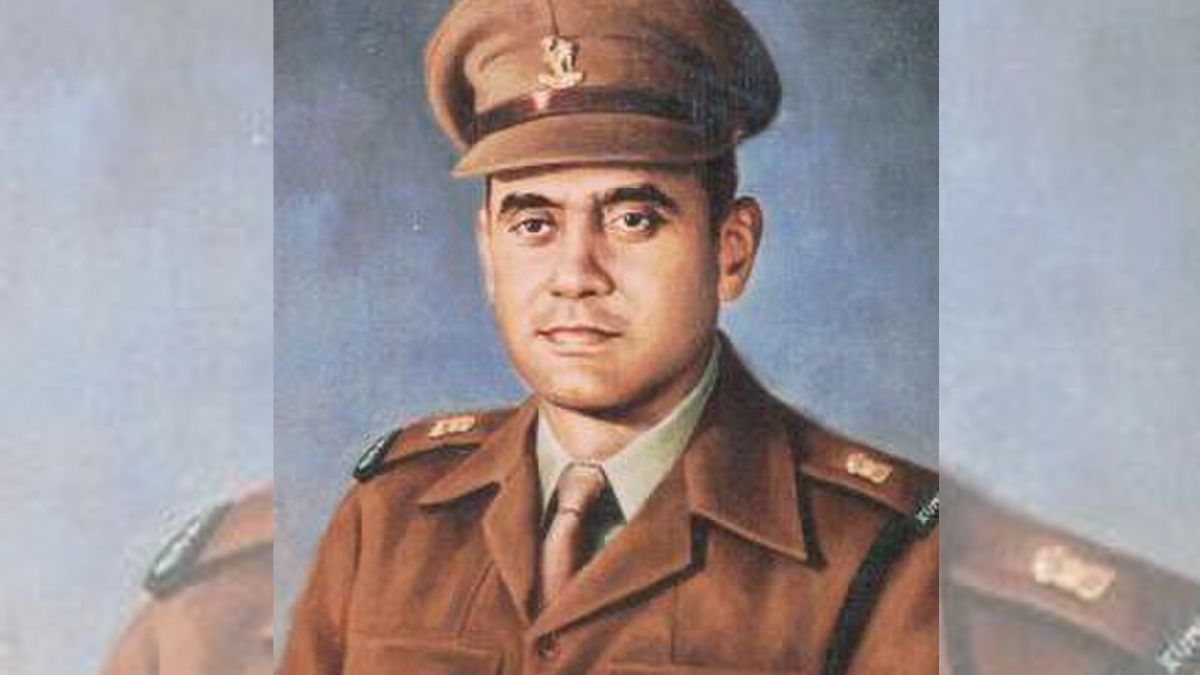Farhan Akhtar’s new film, 120 Bahadur, has brought the 1962 Battle of Rezang La, one of the key fights during India’s war with China, to the limelight. The teaser of the war drama was released on Tuesday (August 5), showcasing the valour of the 120 Indian soldiers who held off an assault by thousands of Chinese troops in sub-zero temperatures.
Akhtar is essaying the role of Major Shaitan Singh Bhati, the commander of the Charlie company who led the Indian soldiers during the Battle of Rezang La. His courage and sacrifice, along with those of his men, helped stave off the Chinese occupation of Rezang La.
Let’s take a closer look.
Who was Major Shaitan Singh Bhati?
Major Shaitan Singh Bhati was the commander of the Charlie Company of the 13 Kumaon Regiment at Rezang La near Pangong Lake.
Born on December 1, 1924, in Banasar village of Rajasthan’s Jodhpur, he came from a military family. Bhati, a Rajput, was the son of Lieutenant Colonel Hem Singh.
The soldiers of the Charlie Company that Bhati led were all Ahirs who hailed from Gurgaon and the Mewat region of Haryana, belonging to communities of cattlemen and farmers.
Bhati died at the age of 37, laying down his life to protect the country against the Chinese troops. His extraordinary valour was recognised and he was posthumously awarded the Param Vir Chakra.
The Battle of Rezang La
The Battle of Rezang La was fought between Indian and Chinese troops on the snowy mountain tops of the Chushul Valley in Ladakh.
Rezang La is a 16,000-foot-high mountain pass located near the strategic village of Chushul and the Spanggur Lake that passes through both Indian and Chinese territories. This pass is crucial for the defence of Chushul.
Impact Shorts
More ShortsThe battle is remembered as a display of great strength of the Indian side in the face of many odds. Indian troops experienced several challenges – they were outnumbered by the Chinese, possessed inferior weaponry and were not acclimatised to winter conditions compared to the Chinese troops, as per ThePrint report.
However, the 120 soldiers of the Charlie Company of 13 Kumaon displayed extraordinary courage as the Chinese attacked on the night of November 18, 1962.
Major Shaitan Singh deployed his three platoons across a two-kilometre frontage to protect Rezang La from the Chinese attack. The soldiers were armed with antiquated .303 single shot bolt action rifles and had some automated digging tools and old 62 radio sets that did not work due to frozen batteries, according to Colonel NN Bhatia (retired).
The Indian soldiers did not have mines to halt the advancing enemy. The overhead shelter for the command posts was not fit for sub-zero temperatures, as per the Indian Express report.
As the Chinese troops advanced on November 18 to occupy Rezang La, two of Major Singh’s platoons opened non-stop rifle, machine gun and mortar fire, repulsing the enemy.
The Chinese side suffered heavy casualties. They responded by intense artillery firing at Indian posts. Later, the Chinese soldiers made another attempt to capture Rezang La.
The 120 Indian soldiers were up against over 2,000 Chinese troops. The third platoon confronted the enemy with all its weaponry. Many Chinese soldiers died, while 20 of the survivors attacked the Indian platoon, leading to a hand-to-hand combat with a dozen soldiers of the Charlie Company.
After failing in its previous attempts, the Chinese again attacked the Indian positions but from the rear this time.
Despite the artillery and mortar barrage by the enemy, the Indian soldiers held on to Chushul. On November 21, the Chinese announced a unilateral ceasefire.
Of the 120 men and officers of the Charlie Company of 13 Kumaon, 114 were martyred. However, they still caused 1,000 fatalities on the Chinese side.
ALSO READ: The Battle of Rezang La: When our men fought the Chinese till the last bullet and the last man
Major Shaitan Singh’s role in Rezang La battle
Major Shaitan Singh Bhati showed bravery at the cost of his life. When the Chinese soldiers attacked his platoons, he constantly moved from one post to another to maintain the morale of his troops.
This brought him under the line of Chinese fire, as he was first hit on his arm, and later in the abdomen. Two of his comrades tried to carry him to safety, but he reportedly told them to put him behind a boulder and continue fighting the enemy.
His body was found months later in the same spot, along with scores of bodies of his troops.
In February 1963, an Indian search party found the corpses on the battlefield. All soldiers were frozen to death, with some still clinging to their guns. Five were taken prisoner by the Chinese.
Each soldier had fired all the ammunition he had, with the C Company fighting till “the last man, last round”.
Brigadier (retd) RV Jatar, a survivor of the battle, recalled Major Bhati as a shy and introverted individual. “On the field, however, he was an excellent and brave officer who held up the highest traditions of the Indian Army,” he was quoted as saying by Indian Express.
The body of Major Shaitan Singh was flown to Jodhpur, with thousands gathered to pay their last respects to the hero of Chushul. He was cremated with full military honours.
With inputs from agencies


)

)
)
)
)
)
)
)
)



